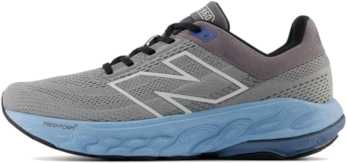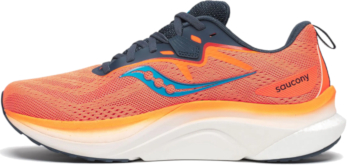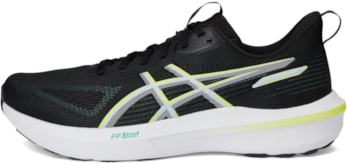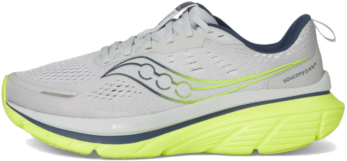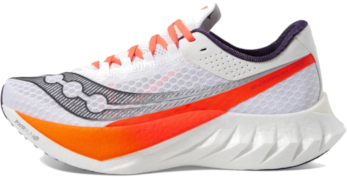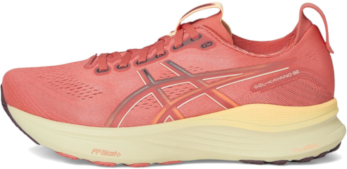Modern stability shoes, especially the best running shoes for overpronation, have come a long way from the bulky, overbuilt models of the past. Today’s designs use lighter, more breathable materials that cut down on fatigue and create a more natural, secure fit. You still get the support you need, but without feeling like you’re carrying extra weight with every step.
What really sets the latest innovations apart is how they deliver stability. Instead of rigid posts or heavy medial systems, many now use dynamic support features that adapt to your gait in real time. They guide your stride rather than forcing it, offering subtle correction where you need it most. Paired with modern cushioning foams, high sidewalls, and wide base, these shoes absorb impact more efficiently, helping reduce the risk of injury during daily training.
While only a few true stability shoes can handle serious speed work, the trend is shifting. Brands are making support shoes lighter, faster, and smoother than ever. For runners who overpronate, that means more responsive rides, better transitions, and a more customized feel whether you’re logging easy miles or pushing the pace.
Table of Contents
- Understanding Overpronation
- Importance of Choosing the Right Running Shoes
- Key Features to Look for
- The Best Running Shoes for Overpronation
- How to Properly Fit Your Running Shoes

Understanding Overpronation
What is Overpronation?
Overpronation is the condition in which the foot rolls excessively inward while walking or running. It happens when the arches fall, leading to a greater flattening of the foot than usual. This biomechanical issue can lead to various foot, knee, and hip problems, as it alters the natural alignment and movement patterns.
Athletes and those who are physically active might encounter discomfort or injuries like plantar fasciitis, shin splints, or knee pain as a result of overpronation. Proper footwear, orthotics, and strength training can help manage and correct overpronation.
Causes and Effects of Overpronation
Overpronation happens when the foot excessively rolls inward while walking or running. Causes include flat feet, weak arches, improper footwear, and genetic factors. Effects can lead to various issues such as plantar fasciitis, knee pain, shin splints, and an increased risk of ankle sprains. Corrective measures consist of supportive shoes, orthotic devices, and targeted exercises designed to enhance the strength of the foot and leg muscles.
Choosing the right running shoes for overpronation is essential for ensuring proper foot alignment and reducing the risk of injuries. These shoes offer enhanced support and cushioning to help mitigate the effects of overpronation and improve your overall running experience.
Identifying Your Pronation Type
To identify overpronation, follow these steps:
- Wet the bottom of your foot and place it on a piece of cardboard or paper to perform the Wet Foot Test. Observe the footprint. If you see a large area connecting the heel and forefoot, it indicates overpronation.
- Wear Pattern on Shoes: Take a close look at the bottoms of your shoes. Overpronators typically show excessive wear on the inner edges of the soles.
- Video Gait Analysis: Record yourself running or walking from the front and side. Watch for excessive rolling inward of the ankle or foot.
- Professional Assessment: Consult a podiatrist or a specialized running store for an analysis of your gait and foot mechanics.
- Foot Flexibility Test: Stand barefoot and try to touch your toes. If your feet roll inward significantly while bending, it may indicate overpronation.

Importance of Choosing the Right Running Shoes
Impact on Performance
Choosing the right running shoes based on performance involves several key factors:
- Cushioning: Evaluate your desired level of cushioning according to your running style and the distance you cover. More cushioning offers comfort for long distances, while less is better for speed.
- Fit: Make sure the shoes are the right size, providing ample space in the toe area and a secure heel to avoid slipping.
- Weight: Lighter shoes improve speed but may offer less support. Balance weight and support based on your performance goals.
- Drop: Analyze the heel-to-toe drop. A lower drop promotes a more natural running posture, whereas a higher drop offers additional cushioning for those who land on their heels.
- Brand and Model: Research reputable brands and specific models that cater to your performance needs, as different brands may fit differently.
Preventing Injuries
Choosing the right running shoes is crucial for injury prevention. Follow these guidelines:
- Cushioning and Support: Choose footwear that provides sufficient cushioning and support tailored to your foot type and running style.
- Fit and Comfort: Make sure there is sufficient space in the toe box. Shoes should provide immediate comfort without requiring any break-in time.
- Test Them Out: Run a few laps in the store or on a treadmill to assess comfort, fit, and support.
- Replace Worn Shoes: Check your shoes’ mileage regularly. Change them every 300-500 miles to prevent injury caused by deteriorated cushioning.
- Seek Expert Guidance: If you have a history of injuries, consider consulting with a podiatrist or a running coach.
Enhancing Comfort
Choosing a comfortable running shoe involves several key factors:
- Fit: Make sure there is sufficient room for your toes (approximately a thumb’s width), and the shoe should feel snug without being overly tight around the midfoot.
- Cushioning: Choose the level of cushioning based on your running style and preferences; more cushioning can provide comfort, while less can offer better ground feel.
- Weight: Lighter shoes can enhance speed but may provide less support; balance weight with comfort based on your running goals.
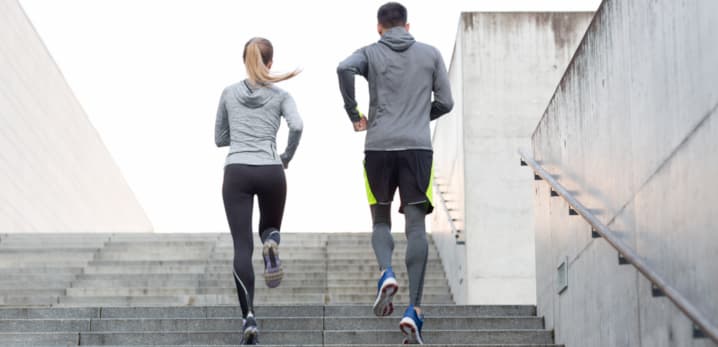
Key Features to Look for in the Best Running Shoes for Overpronation
Arch Support
For runners who overpronate, seek out shoes that offer stability or motion control features. These types of shoes typically provide firmer arch support and additional cushioning to help stabilize the foot and control excessive inward rolling during the running stride.
Key characteristics include a supportive midsole, a medial post for extra support on the inner side, and a structured heel counter to maintain alignment. Consider brands that specialize in overpronation support, and always ensure a proper fit to enhance comfort and reduce the risk of injury.
Cushioning
The shoes with the right cushioning have additional arch support and a structured heel to maintain proper alignment. A good choice of materials should provide shock absorption while allowing for flexibility in the forefoot. It’s crucial to ensure that the cushioning is responsive enough to handle the impact during runs, while also providing support to prevent injuries.
Stability and Motion Control
The stability and motion control features found in running shoes are intended to provide support for the foot and inhibit excessive inward rolling. Stability shoes typically include a firmer midsole on the medial (inner) side, which helps guide the foot into a more neutral alignment during the running gait. Motion control shoes offer additional support, often featuring a more rigid structure that limits excessive motion.
By providing these features, running shoes help maintain proper biomechanics, reduce strain on the arches, and minimize the risk of related injuries such as plantar fasciitis or shin splints. Properly fitted stability or motion control shoes can enhance overall comfort and performance for runners prone to overpronation.
Fit and Comfort
Fit and comfort play crucial roles in preventing overpronation. Properly fitting shoes provide the necessary support and stability to the foot, reducing excessive inward rolling during walking or running. Comfortable footwear encourages a natural gait, allowing for even weight distribution and minimizing strain on the arches. Selecting shoes with appropriate cushioning and arch support can help align the foot correctly, reducing the likelihood of overpronation and associated injuries.
The Best Running Shoes for Overpronation
Here’s a list of the best running shoes for overpronation (in no particular order):
New Balance Fresh Foam X 860v14
The New Balance 860v14 is one of the best running shoes for overpronation due to its combination of stability, comfort, and cushioning. If you have moderate to severe overpronation, this is the running shoe for you because it has true medial support that helps align the foot so you won’t have running-related pains even if you overstride. And it’s the only recommended shoe for plantar fasciitis on this list.
This shoe features a supportive Fresh Foam X midsole that provides soft landings and responsive takeoffs, helping to correct overpronation without sacrificing comfort. Its medial post design offers additional support for the arch, promoting a more natural foot motion. The engineered mesh upper also enhances breathability while ensuring a snug fit, reducing the risk of blisters during long runs.
Brooks Hyperion GTS 2
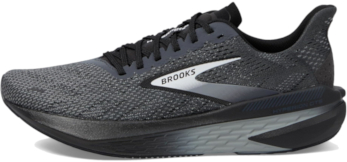
The Books Hyperion GTS 2 is the lightest and fastest stability running shoe, weighing only 7.6oz. It boasts a lightweight mesh upper that improves ventilation and ensures a snug fit. The shoe incorporates nitrogen-infused DNA FLASH v2, a responsive cushioning technology that maximizes energy return, allowing for quicker transitions and a faster tempo.
Additionally, it uses GuideRails system, a strategically positioned support that guides the foot without adding unnecessary weight, ensuring a smooth and efficient running experience. The combination of these elements results in a shoe that promotes speed while maintaining stability, making it ideal for competitive runners.
Saucony Tempus 2
The Saucony Tempus 2 is considered one of the quickest stability running shoes thanks to its lightweight build, responsive cushioning, and cutting-edge design elements. It incorporates Saucony’s PWRRUN foam, which provides a perfect blend of comfort and energy return, allowing for quicker transitions and enhanced speed. This cushioning also works well with overpronators.
The shoe also features a carbon-fiber plate that promotes a propulsive toe-off, making it ideal for speed workouts and races. Additionally, its secure fit and supportive structure help maintain stability without adding excessive weight, which contributes to a faster running experience. Overall, the combination of these elements makes the Tempus 2 a top choice for runners seeking speed without compromising stability.
ASICS GT-1000 14
The ASICS GT-1000 14 is a dependable, budget-friendly option for runners who overpronate, delivering the stability you need without the premium price. Its 3D Guidance System helps control excessive inward rolling, improving alignment and reducing the risk of common overpronation-related issues like shin splints and knee pain. Underfoot, FF BLAST foam brings a lightweight, responsive feel typically reserved for more expensive ASICS models, while rearfoot PureGEL softens impact at heel strike for a smoother, more forgiving ride, especially useful for high-mileage training or injury recovery.
On top, an engineered mesh upper keeps airflow steady and the fit secure, supported by a firm heel counter that adds extra stability. Despite its accessible price point, the GT-1000 14 holds its own in durability and comfort, making it a smart choice for runners who want reliable support and everyday cushioning without overspending.
Saucony Guide 18
The Saucony Guide 18 is built for runners who need structured support but still want a smooth, responsive ride. Its medial TPU guidance frame helps correct overpronation by gently steering the foot into a more neutral path, reducing strain on the arch and protecting the knees, hips, and lower back. The updated PWRRUN midsole strikes a great balance—soft enough to absorb impact yet firm and lively enough to stay efficient at toe-off. A slightly wider base adds even more stability, helping prevent the inward collapse that often leads to fatigue and discomfort.
Comfort is also a major highlight. The engineered mesh upper boosts breathability while providing secure midfoot lockdown, and Saucony’s FORMFIT system adapts to your foot’s unique shape for a snug, pressure-free fit. Strategic rubber placement and flex grooves in the outsole keep transitions smooth and reduce torsional stress, all while improving durability in high-wear zones. Whether you’re training for distance or cruising through daily miles, the Guide 18 offers reliable alignment, consistent comfort, and the kind of stability that doesn’t get in your way.
Saucony Endorphin Pro 4
If you are a mild overpronator looking for a fast, stable marathon shoe for race day and everyday training, the Saucony Endorphin Pro 4 is probably your best option. Although it’s technically a neutral shoe, it received plenty of admiration from overpronators due to its unique stability features. It’s even lighter than the Saucony Tempus 2 and is also an excellent, stable running shoe for speed training.
The Endorphin Pro 4 keeps things light and fast, helping you pick up speed without burning extra energy on long runs. A full-length carbon-fiber plate in the midsole delivers that signature propulsive snap, making each stride feel more efficient and effortless. Saucony’s responsive PWRRUN PB and PWRRUN HG foams work together to maximize energy return, while the large sidewalls and wide midfoot platform add stability to help you hold your pace deep into the miles.
The aerodynamic shape and breathable upper contribute to overall comfort and efficiency, making it an optimal choice for competitive marathon runners seeking to improve their performance.
ASICS Gel-Kayano 32
The ASICS Gel-Kayano 32 is widely regarded as the best stability running shoe for heavy runners due to its maximum cushioning, support, and durability. The shoe features advanced Gel technology that absorbs shock, reducing impact on joints during runs. Its new 4D Guidance System enhances stability without compromising comfort, making it ideal for heavier runners who require adaptive, on-demand stability.
The breathable engineered mesh upper ensures a comfortable fit, while the robust outsole, which features Hybrid AsicsGrip, provides excellent traction and longevity, allowing for a smooth and reliable running experience. Overall, the Gel-Kayano 32 combines performance and comfort, making it the top choice for stability in heavy runners.
Heads up: As an Amazon Associate, we earn from qualifying purchases.
How to Properly Fit Your Running Shoes
Measuring Your Feet
To fit your running shoes properly, follow these steps:
- Measure Your Feet: Utilize a Brannock device or a tape measure to determine both the length and width of your feet. Always measure in the afternoon when your feet are slightly swollen.
- When trying on shoes, make sure to wear the type of socks you intend to use for running to guarantee a proper fit.
- Select the Correct Size: Your running shoes should be half to a full size larger than your usual footwear. There should be approximately a thumb’s width of distance between your longest toe and the shoe’s toe box.
- Check the Width: Ensure the shoes are snug but not tight. Your foot should feel snug without any pinching or chafing.
- Evaluate Arch Support: Determine if the shoe offers sufficient arch support based on your foot type.
- Break-in Period: Keep in mind that running shoes should be comfortable from the start, although they may need a brief adjustment period.
Trying on Shoes
It’s essential to try on shoes before making a purchase for a number of reasons. Firstly, it guarantees an appropriate fit, which helps prevent discomfort and possible foot issues. Second, it allows you to assess the shoe’s support and cushioning, which can vary significantly between brands and styles. Lastly, trying on shoes helps you gauge how they feel during movement, ensuring they meet your needs for activities like walking or running.
Assessing Fit and Comfort
To assess fit and comfort in a running shoe, follow these steps:
- Determine Your Foot Size: Stand up and measure both of your feet. Note the length and width of the wider foot.
- Test shoes in the afternoon: Your feet tend to swell as the day progresses, so trying on shoes later in the day will give you a more precise fit.
- Wear Proper Socks: Use the type of socks you’ll wear when running to ensure the best fit.
- Examine the toe box: Make sure there’s approximately a thumb’s width of space between your longest toe and the shoe’s front. Your toes should have enough space to move comfortably without feeling restricted.
- Heel Fit: The heel should fit securely without any slipping. Walk around to assess how the heel fits as you move.
- Midfoot Support: Ensure the midfoot area feels secure without excessive tightness.
- Flexibility: Curve the shoe at the ball of the foot. It should flex easily but not too much.
- Cushioning: Press down on the insole to check for adequate cushioning that feels comfortable underfoot.
- Comfort Test: Take a few minutes to walk or jog around the store. Be mindful of any areas of discomfort or pressure.
- Assess Overall Feel: The shoe should feel like an extension of your foot, with no pinching or excessive movement.
Final Thougths on the Best Running Shoes for Overpronation
Overpronation can lead to excessive inward rolling of the foot, causing instability. But proper shoes provide the necessary support to maintain foot alignment. Running shoes specifically designed for overpronators assist in shock absorption and lower the likelihood of injuries. These running shoes are tailored for overpronation and offer additional cushioning and support, leading to a more comfortable running experience. The appropriate footwear can improve your running efficiency, leading to enhanced performance and stamina.
(This content was created with the help of AI.)
You may also like:

